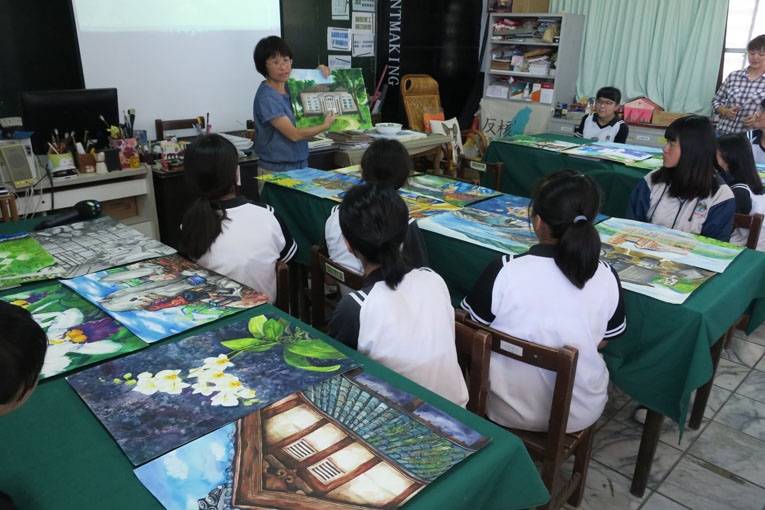
News source: Renewal Daily/Li Jieyu
News link:http://www.ksnews.com.tw/index.php/news/contents_page/0001187893
Guofeng Junior High School's cross-field aesthetic education experimental course results Chinese liberal arts combined with the beauty of words Mathematics The beauty of symmetry from the perspective of composition
Guofeng Junior High School is the only junior high school in Hualien that has an art class. It has designed a six-semester "Cross-disciplinary Aesthetic Education Experimental Course" in line with the teaching progress. Recently, Guofeng Junior High School compiled the teaching results of the six courses in the past five years and compiled them. The e-book has been published and is expected to be launched on October 5th. It will serve as a reference for the first interdisciplinary aesthetic education curriculum applicable to grades 7, 8 and 9 in the country's middle schools.
Using art as a bridge to carry out diversified learning, development and aesthetic experience
The 12-year national education curriculum will be launched next September. The core spirit of the new curriculum is innovative education and interdisciplinary education. Currently, there are 177 national, high school and elementary schools at all levels in Taiwan. With the help of teachers, Driven by this, we invested in the "Cross-disciplinary Aesthetic Education Experimental Curriculum Development Project" commissioned by the Ministry of Education and implemented by the National Taiwan Normal University, using art as a bridge to develop diversified learning, development and aesthetic experiences.
The eight schools in Hualien County participating in the cross-disciplinary aesthetic education experimental course include Hualien High School, Guofeng Junior High School, Zhongxiao Elementary School, Guanyin Elementary School, Shuiyuan Elementary School, Jingmei Elementary School, Xilin Elementary School, and Donghua Affiliated Elementary School, among which China Feng Elementary School and Guanyin Elementary School are the leading schools.
In the five years since the plan was implemented, Guofeng Junior High School has designed interdisciplinary courses based on the curriculum progress of seventh, eighth, and ninth grade junior high schools in various fields, taking advantage of Hualien’s unique natural and cultural landscapes, using art forms and various disciplines. There are Mathematics/Natural Science (Earth Science)/English/Civics/History and Geography/Chinese Language.
Publish cross-field aesthetic education course e-book
A six-semester "cross-field aesthetic education experimental course" was designed to match the teaching progress. The cross-field experimental course planning team of Normal University and Professor Luo Meilan of Donghua University assisted in the editing and published Taiwan's first cross-field aesthetic education course e-book. , providing reference for schools across the country for the cross-field courses focused on next year’s new curriculum.
Guanyin Elementary School uses the "Maple Forest Children's Music Club", which is a cross-disciplinary aesthetic experimental course on vision, performance, nature, Mandarin, and information. All students in the school look for local natural materials such as bamboo sticks, coconuts, stones, PET bottles, etc. to make musical instruments. We also made homemade invitation cards to create a concert in the maple forest, inviting parents and community members to participate.
Liu Qimin, principal of Guofeng Junior High School, said that Guofeng Junior High School has not only made repeated innovations in art-related teaching, but also spared no effort in the development of cross-field aesthetic education experimental courses. Five years ago, I started to participate in cross-field experimental courses. Courses in various fields have discussions and collaborative teaching with the art department. For example, the Chinese liberal arts department combines the beauty of words, mathematics looks at the "beauty of symmetry" from graphic creation, spatial concepts and composition, and earth sciences Explore the beauty of rose stone textures from rock structures.
Art class instructor Tang Xiangying said that since the 103 school year, a cross-field plan has been implemented to combine various fields with the professional skills of art class students. In the past five years, the six courses have highlighted products including flowing ink stone murals, beauty of symmetry Paintings, etc., and also making playing cards, postcards, bookmarks, and badges with Hualien’s local characteristics. The implementation results have recently been produced into an e-book and are expected to be launched at the national seminar on October 5th for reference by schools across the country.
Beauty is not limited to art
Chinese language teacher Zheng Shuling said that for the cross-field course, she has done enough homework, collected relevant information everywhere, and asked students to discuss and research in groups, such as conducting interviews on the theme of Dongdaemun Night Market, or combining the activities of the Pacific Poetry Festival, the largest The gain and affirmation is that children learn that beauty is not limited to art, but to discover the beauty of life and cultivate students' artistic cultivation.
Natural science teacher Zhang Yating said that she had never thought that nature could be combined with art. From a scientific point of view, the "hard" Hualien ore is caused by the pushing of high temperature and high pressure, but from an aesthetic and artistic point of view, it is Appreciating the beauty of its texture and color not only understands the origin of the ore, but also deeply understands the natural environment of Hualien. It also has an emotional connection with life, which helps students to develop their artistic creation.





